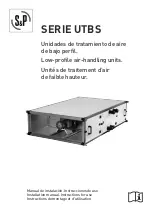
JOHNSON CONTROLS
57
SECTION 3 - MAINTENANCE
FORM 102.20-OM2
ISSUE DATE: 6/01/2015
3
Checking Belt Tension
Check the belt tension. It is normal for belts to loosen
after start-up or replacement. The new belt will
run in
or
take a set
by seating slightly deeper into the grooves
of the sheaves. Recheck tension after one day, and
again after three days.
1. Measure the belt span as shown in
.
BELT SPAN
SPAN LENGTH
DEFLECTION
FIGURE 46 -
BELT TENSIONING
LD05627a
2. Position bottom of the large O-ring on the span
scale at the measured belt span as shown in
.
15 20 25 30
Small
O-ring
50
100
15
0
Span
Scale
Deflection
Force
Scale
INCHES of SPAN
Large
O-ring
FIGURE 47 -
BELT TENSIONING GAUGE
LD05628a
3.
Set the small O-ring on the deflection force scale
to zero.
4. Place the tension gauge squarely on one belt at
the center of the belt span. Apply a force on the
plunger and perpendicular to the belt span until
the bottom of the large O-ring is even with the top
of the next belt or with the bottom of a straight
edge laid across the sheaves.
5. Remove the tension gauge and read the force ap-
plied from the bottom of the small O-ring on the
deflection force scale.
6. Compare the force you have applied with the
value given on the drive kit data tag as shown in
Never use excessive tension because this
could result in damaging the bearing,
motor pulleys or motor base. Refer to the
drive label on the fan housing for specific
details on tension. Squealing belts during
starting is caused by slipping belts that are
not tensioned properly.
ALIGNING SHEAVES
An incorrectly aligned sheave can sub-
stantially shorten belt life or overload
blower and motor bearings, shortening
their life expectancy. A belt tensioned too
tightly can overload the motor electrically,
causing nuisance tripping of the motor
overloads and/or motor failure and/or
shaft failure.
Sheave alignment and parallelism of shafts is very
important. Proper alignment helps equalize the load
across the entire belt width, thereby reducing wear and
extending belt life.
shows how
to align a synchronous drive properly using a straight-
edge or shows how to use
a piece of string as shown in
After aligning the sheaves, check the rigidity of the
supporting framework. Shafts should be well support-
ed to prevent distortion and a resulting change in the
center distance under load. Do not use spring-loaded
or weighted idlers.






































